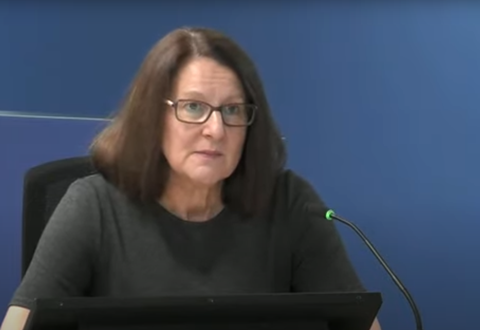Official wrote to the NHBC asking it to rebut claims that tower’s combustible cladding panels complied with building regulations
A government official wrote to the UK’s largest building control body two days after the Grenfell fire asking it to rebut claims that the tower’s deadly cladding panels were permitted under building regulations.
Senior official Brian Martin wrote to the National House Building Council (NHBC) with a “pre-prepared script” which defended the government against a report in the Times, 48 hours after the fire, which said combustible ACM panels complied with fire safety guidance.
Thursday’s hearing of the inquiry into the blaze which claimed 72 lives on 14 June 2017 was shown an email sent two days later from Martin to the NHBC’s now operations director, Diane Marshall.

It said: “Apologies in advance for asking but; I’ve been asked to prepare a rebuttal of the assertion that [combustible] cored ACM panels comply with the guidance in ADB [Approved Document B] .
“I’ve also been asked if an independent expert would be willing to say this (or something similar) in public? Can you consider the attached and let me know please.”
The correspondence reveals the government’s attempts to manage the media fallout of the disaster in the immediate aftermath of the fire, as ministers sought to explain how such a combustible material had been used on a 67m tall residential building.
Inquiry to the counsel Richard Millett QC asked Marshall: “Did you consider it appropriate that a government official was approaching you with a pre−prepared script, or proposed pre−prepared script, in support of government after the Grenfell Tower fire?
Marshall replied that it was “unusual”.
“Yes, but was it appropriate?”, Millett asked, to which Marshall said: “I don’t know if I considered it at the time.”
The Times article had focused on a passage in Approved Document B, part of building regulations, which said that “filler material” in external walls of buildings taller than 18m should be of “limited combustibility”.
This had generated some confusion in the industry, as it was widely believed that “filler” referred to materials used to fill gaps between insulation components rather than the core of cladding panels.
Marshall told the hearing: “The definition of ‘filler etc’ was open to interpretation and we saw that through our role as a warranty body, where there were different approaches to ‘filler etc’.”
In a document shown to the inquiry, Martin provided Marshall with a suggested text which said that the type of panels used on Grenfell tower could not have complied with building regulations, which Marshall had said she “fully agree[d]” with.
But the inquiry has already heard that the NHBC approved in principle the use of ACM panels without requiring either a fire test or a ‘desktop’ assessment as long as they met certain minimum specifications.
NHBC fire engineer John Lewis admitted earlier this week that the guidance, introduced in 2016, had been produced to reduce the workload of staff at the NHBC.
Millett asked Marshall: “How did your agreement with Brian Martin’s suggested text conform with NHBC’s 2016 guidance note, which allowed external cladding panels with a class B classification?”
Marshall replied: “Because they excluded polyethylene−cored panels by the restrictions of use.”
Millett said: “You say that, but was in fact not the real problem here that you couldn’t be seen to be disputing the assertion that a polythene−cored panel was acceptable for use under current building regulations precisely because your 2016 guidance note said, at least on one reading, but I would put to you clearly, that you accepted [combustible]−cored ACM panels so long as they achieved class B? 12 A.
Marshall said that she disagreed with Millett’s assertion.
The inquiry continues.










No comments yet